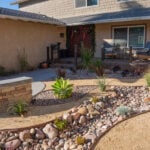Hardscaping, often regarded as the artful integration of non-living elements into outdoor environments, stands as a testament to the evolving preferences of homeowners seeking to elevate both the beauty and utility of their living spaces. As the demand for aesthetically pleasing and functional outdoor areas continues to rise, the allure of hardscaping has grown exponentially. From the creation of inviting patios and seamlessly designed driveways to the structurally significant retaining walls and the culinary sanctuaries of outdoor kitchens, hardscaping has emerged as a transformative force, turning once-ordinary spaces into captivating and purposeful realms.
Despite the evident appeal of hardscaping, a common apprehension looms large among homeowners—the financial investment required for such projects. The intricate dance between creativity and cost-effectiveness becomes crucial as individuals aspire to realize their outdoor dreams without breaking the bank. In the following sections, we embark on a comprehensive exploration of the multifaceted realm of hardscaping costs, unraveling the intricacies of materials, labor, and design considerations that collectively shape the economic landscape of these transformative endeavors. Join us on this insightful journey as we dissect the various factors that play a pivotal role in determining the expenses associated with hardscaping, empowering you to make informed decisions and embark on your own journey toward a visually enchanting and functionally enriched outdoor haven.
Factors Influencing Costs
Material Selection
The choice of materials is a primary determinant of hardscaping costs. Different materials come with varying price points, and homeowners often base their decisions on factors such as durability, aesthetics, and maintenance requirements. Here are some common hardscaping materials and their associated costs:
- Pavers and Bricks: Pavers and bricks are popular choices for patios and walkways. The cost can range from $5 to $25 per square foot, depending on the quality and type of material.
- Natural Stone: Natural stone, such as granite, limestone, or slate, can significantly elevate the aesthetic appeal of hardscaping projects. However, it comes at a higher cost, typically ranging from $15 to $30 per square foot.
- Concrete: Concrete is a versatile and cost-effective option for various hardscaping elements. Basic concrete may cost around $6 to $10 per square foot, while stamped or stained concrete can increase the price to $12 to $18 per square foot.
- Wood: Wooden elements, like decks and pergolas, can add warmth to outdoor spaces. However, the cost varies widely depending on the type of wood used. Hardwoods like teak or ipe are more expensive, ranging from $20 to $50 per square foot, while pressure-treated wood is more budget-friendly at $10 to $25 per square foot.
Labor Costs
The expertise and labor required for hardscaping projects contribute significantly to the overall expense. Skilled professionals, such as landscape architects and experienced contractors, may charge higher fees for their services. Labor costs can be broken down into various components:
- Design and Planning: Engaging a landscape architect for a detailed hardscaping design can incur additional costs, often ranging from 5% to 15% of the overall project budget.
- Installation: The complexity of the hardscaping design and the skill level required for installation influence labor costs. For instance, intricate patterns in paver installations or the construction of elaborate outdoor kitchens may require more time and skill, thereby increasing labor expenses.
- Permits and Inspections: Depending on local regulations, obtaining permits for hardscaping projects may be necessary. Permit fees and any required inspections can add to the overall costs.
Site Preparation and Accessibility
The condition of the site and its accessibility can impact hardscaping costs. If extensive excavation or grading is required, additional expenses for machinery, labor, and disposal of excavated material may accrue. Similarly, if the site is challenging to access, such as in urban areas with limited space, the logistics of transporting materials and equipment can contribute to higher costs.
Project Size and Scope
The size and scope of the hardscaping project directly correlate with its cost. Larger projects naturally require more materials, labor, and time. Additionally, projects that involve intricate designs, custom features, or the integration of multiple hardscaping elements tend to be more expensive.
Geographic Location
The cost of hardscaping can vary based on geographic location. Factors such as regional labor rates, availability of materials, and local building codes can influence overall project expenses. For example, hardscaping projects in urban areas with high living costs may incur higher labor charges than those in rural areas.
Maintenance Considerations
While not a direct upfront cost, considering the long-term maintenance requirements of hardscaping elements is crucial. Some materials, like natural stone, may require more maintenance to preserve their appearance, potentially incurring additional costs over time.
Case Studies
To provide a more tangible understanding of hardscaping costs, let’s explore two hypothetical case studies:
Basic Patio Installation:
-
- Material: Concrete pavers
- Size: 200 square feet
- Labor: Standard installation with minimal site preparation
- Total Cost: $3,000 to $6,000
Elaborate Outdoor Kitchen and Patio:
-
- Materials: High-quality pavers, natural stone countertops, built-in kitchen appliances
- Size: 500 square feet
- Labor: Skilled installation with custom features, extensive site preparation
- Design and Planning: Additional fees for a detailed design
- Total Cost: $25,000 to $50,000
Navigating Hardscaping
Hardscaping can significantly enhance the visual appeal, functionality, and value of outdoor spaces. While the costs associated with hardscaping projects can vary widely, depending on factors such as material selection, labor, site conditions, and project scope, it’s essential for homeowners to carefully consider their budgets and priorities. Working with experienced professionals, obtaining detailed quotes, and understanding the long-term maintenance requirements of chosen materials can help ensure a successful and cost-effective hardscaping project. Ultimately, the investment in hardscaping can provide a lasting and enjoyable outdoor living space for years to come.






